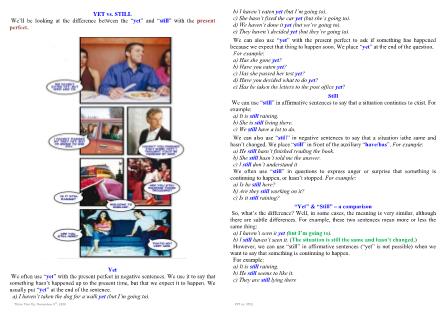Tài liệu ôn thi môn Tiếng Anh - Chuyên đề: Yet và Still trong thì hiện tại hoàn thành

We can use “still” in affirmative sentences to say that a situation continues to exist. For
example:
a) It is still raining.
b) She is still living there.
c) We still have a lot to do.
We can also use “still” in negative sentences to say that a situation isthe same and
hasn’t changed. We place “still” in front of the auxiliary “have/has”. For example:
a) He still hasn’t finished reading the book.
b) She still hasn’t told me the answer.
c) I still don’t understand it
We often use “still” in questions to express anger or surprise that something is
continuing to happen, or hasn’t stopped. For example:
a) Is he still here?
b) Are they still working on it?
c) Is it still raining?
“Yet” & “Still” – a comparison
So, what’s the difference? Well, in some cases, the meaning is very similar, although
there are subtle differences. For example, these two sentences mean more or less the
same thing:
a) I haven’t seen it yet (but I’m going to).
b) I still haven’t seen it. (The situation is still the same and hasn’t changed.)
However, we can use “still” in affirmative sent
Thẩm Tâm Vy, November 9th, 2020 YET vs. STILL YET vs. STILL We’ll be looking at the difference between the “yet” and “still” with the present perfect. Yet We often use “yet” with the present perfect in negative sentences. We use it to say that something hasn’t happened up to the present time, but that we expect it to happen. We usually put “yet” at the end of the sentence. a) I haven’t taken the dog for a walk yet (but I’m going to). b) I haven’t eaten yet (but I’m going to). c) She hasn’t fixed the car yet (but she’s going to). d) We haven’t done it yet (but we’re going to). e) They haven’t decided yet (but they’re going to). We can also use “yet” with the present perfect to ask if something has happened because we expect that thing to happen soon. We place “yet” at the end of the question. For example: a) Has she gone yet? b) Have you eaten yet? c) Has she passed her test yet? d) Have you decided what to do yet? e) Has he taken the letters to the post office yet? Still We can use “still” in affirmative sentences to say that a situation continues to exist. For example: a) It is still raining. b) She is still living there. c) We still have a lot to do. We can also use “still” in negative sentences to say that a situation isthe same and hasn’t changed. We place “still” in front of the auxiliary “have/has”. For example: a) He still hasn’t finished reading the book. b) She still hasn’t told me the answer. c) I still don’t understand it We often use “still” in questions to express anger or surprise that something is continuing to happen, or hasn’t stopped. For example: a) Is he still here? b) Are they still working on it? c) Is it still raining? “Yet” & “Still” – a comparison So, what’s the difference? Well, in some cases, the meaning is very similar, although there are subtle differences. For example, these two sentences mean more or less the same thing: a) I haven’t seen it yet (but I’m going to). b) I still haven’t seen it. (The situation is still the same and hasn’t changed.) However, we can use “still” in affirmative sentences (“yet” is not possible) when we want to say that something is continuing to happen. For example: a) It is still raining. b) He still seems to like it. c) They are still lying there
Tài liệu đính kèm:
 tai_lieu_on_thi_mon_tieng_anh_chuyen_de_yet_va_still_trong_t.pdf
tai_lieu_on_thi_mon_tieng_anh_chuyen_de_yet_va_still_trong_t.pdf



